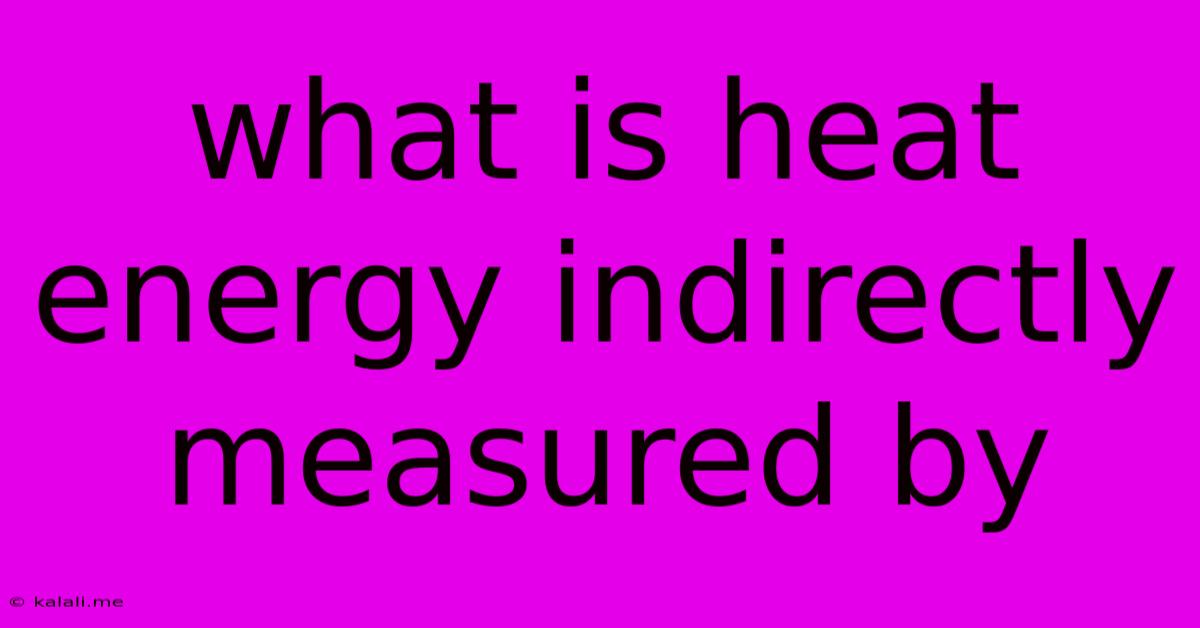What Is Heat Energy Indirectly Measured By
Kalali
May 09, 2025 · 3 min read

Table of Contents
What is Heat Energy Indirectly Measured By?
Heat energy, a form of energy resulting from the movement of atoms and molecules within a substance, isn't directly measured like length or weight with a ruler or scale. Instead, its effects are measured to infer the amount of heat energy present. This article explores the various methods used to indirectly measure heat energy, focusing on the principles behind each technique. Understanding these indirect measurements is crucial in various fields, from meteorology to materials science.
Why We Can't Directly Measure Heat Energy:
Heat energy is a manifestation of kinetic energy at a microscopic level. We can't directly observe or count the movement of individual atoms and molecules to quantify the total heat energy. Therefore, we rely on observable effects caused by heat transfer to deduce its quantity.
Common Indirect Measurement Methods:
Several methods indirectly measure heat energy based on its impact on physical properties:
-
Temperature: This is the most common and intuitive way. Temperature reflects the average kinetic energy of the particles in a substance. A higher temperature generally implies a greater amount of heat energy. Thermometers, utilizing different principles like thermal expansion or electrical resistance, measure temperature, giving us an indication of heat energy. However, it's important to remember that temperature doesn't directly represent the total heat energy, as a large object at a lower temperature can contain more heat energy than a small object at a higher temperature.
-
Thermal Expansion: Most materials expand when heated, increasing their volume. The degree of expansion is proportional to the temperature change and, consequently, the heat energy gained. This principle is used in bimetallic strips (found in thermostats) and liquid-in-glass thermometers. Measuring the expansion allows for an indirect measurement of the heat energy transferred.
-
Heat Capacity and Specific Heat: These properties describe how much heat energy is required to raise the temperature of a substance. The equation Q = mcΔT (where Q is heat energy, m is mass, c is specific heat, and ΔT is the temperature change) showcases the relationship. By knowing the mass, specific heat, and temperature change of a substance, we can calculate the heat energy involved.
-
Calorimetry: This technique uses a calorimeter – an insulated container – to measure the heat energy transferred during a chemical or physical process. By observing the temperature change of a known mass of water (or another substance with known specific heat) within the calorimeter, the heat energy exchanged can be calculated. Calorimetry is a widely-used method in chemistry and physics experiments.
-
Changes in State: Heat energy is also involved in phase transitions, like melting or boiling. The amount of heat energy required to change the state of a substance (latent heat) is directly proportional to its mass. Measuring the amount of substance changing state can provide an indirect measurement of the heat energy involved. For instance, measuring the amount of ice melted can tell us about the heat energy supplied.
-
Electrical Resistance: The electrical resistance of some materials changes with temperature. Thermistors exploit this property. Measuring the change in resistance allows for a precise temperature measurement, indirectly indicating heat energy. This method is often used in electronic temperature sensors.
Conclusion:
While we cannot directly measure heat energy, its impact on various physical properties provides effective indirect measurement methods. These methods, ranging from simple temperature readings to sophisticated calorimetric techniques, are crucial across various scientific and engineering disciplines to understand and quantify this fundamental form of energy. The choice of method depends heavily on the context and the precision required.
Latest Posts
Latest Posts
-
What Percentage Is 34 Out Of 50
May 09, 2025
-
Does A Snail Have A Backbone
May 09, 2025
-
How Do You Draw A Quadrilateral
May 09, 2025
-
25 3 As A Mixed Number
May 09, 2025
-
Which Three Are Formed Due To Compression
May 09, 2025
Related Post
Thank you for visiting our website which covers about What Is Heat Energy Indirectly Measured By . We hope the information provided has been useful to you. Feel free to contact us if you have any questions or need further assistance. See you next time and don't miss to bookmark.